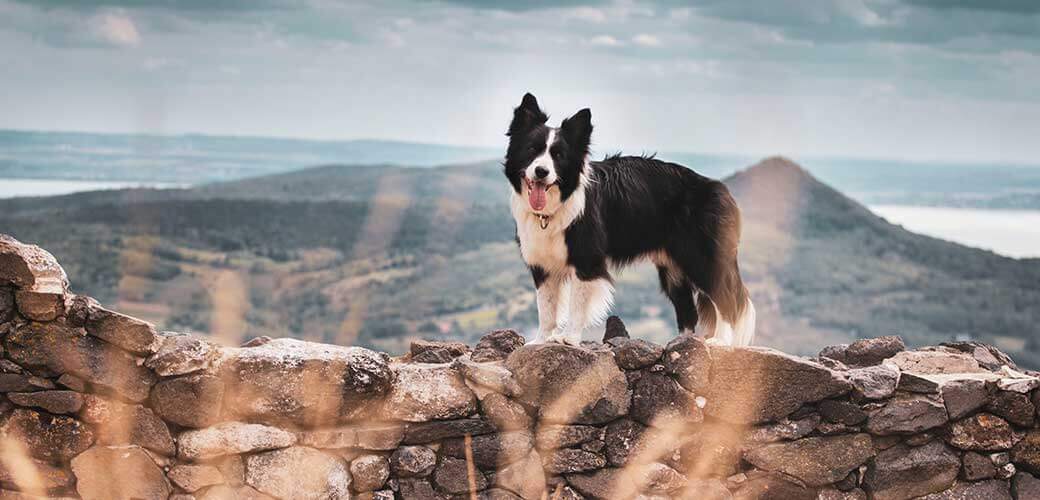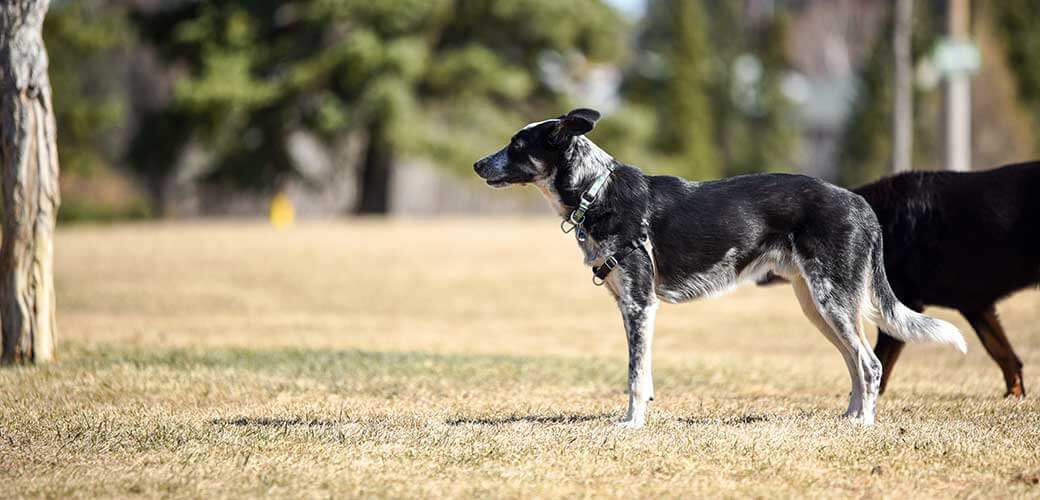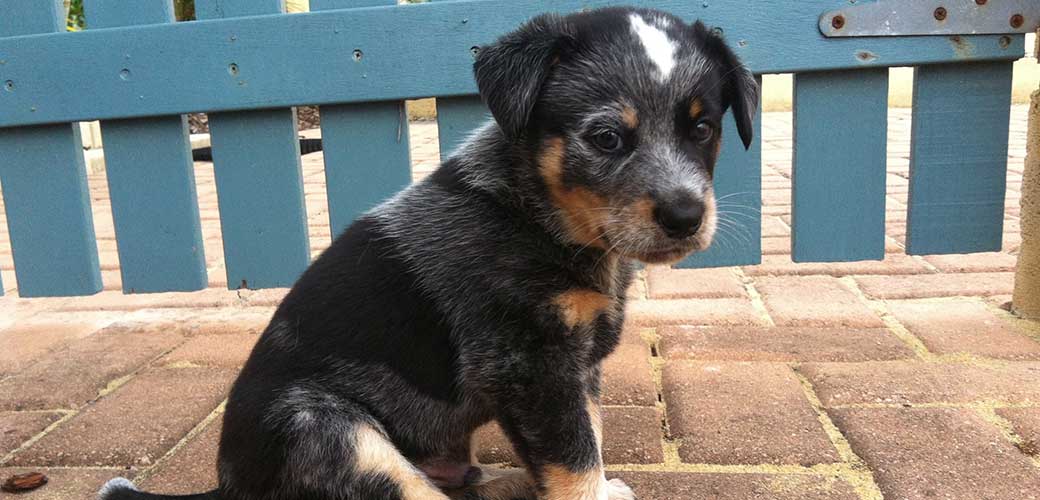When looking for a new canine companion, a lot of people tend to have a particular breed in mind. Of course, border Collies and Australian Cattle dogs are among two of the most popular dog breeds, but did you know these canines are responsible for a highly underrated, charming mixed-breed known as the Border Heeler?
The Border Collie Blue Heeler, as it’s also known, is an adorable and endearing cross between the two herding breeds. There’s a lot to be said about them, but they are not without faults. Overall, they are loyal, protective, and incredibly playful but also have the energy of a child that’s been let loose in a candy store. So if you’re curious to learn more about these designer dogs, read on!
Border Heeler Breed Overview
- Parent Dogs: Border Collie & Blue Heeler (AKA Australian Cattle dog)
- Height: 17 – 20 inches (Depending on gender)
- Weight: 30 – 55 pounds (Depending on gender)
- Lifespan: 13 – 17 years
Blue Heeler Border Collie Top Facts:
- Blue Heeler Border Collies are a hybrid and are not purebred dogs.
- Border Heelers are incredibly intelligent and loyal.
- They are known to be cautious and watchful of strangers.
- The Border Heeler is classed as a medium-sized dog.
- It’s unknown when the first Border Collie Heeler was bred, as no source can definitively state a year.
- These dogs are not considered hypoallergenic due to moderate shedding qualities.
What is a Border Collie Blue Heeler Mix?
A Border Collie Blue Heeler mix is the offspring of two well-known dog breeds, the Border Collie and Blue Heeler (also known as a Queensland Heeler). Although their parent breeds are popular amongst dog lovers, the Border Heeler is not as established, which is surprising given their incredible traits and personalities.
Common names used for the Blue Heeler Border Collie mix:
- Border Collie Blue Heeler Mix
- Border Heeler
- Collie Heeler
- Border Collie Heeler mix
- Australian Cattle dog mix
- Heeler Border Collie mix
- Australian Heeler Collie mix
Border Heeler Breed History & Notable Attributes
To fully understand the Border Collie Blue Heeler mix, it’s important to understand more about their parent breeds. Blue Heelers and Border Collies, in particular, have an interesting history, defining personality traits that have been passed down to their Border Collie Blue Heeler pups.
The Blue Heeler parent breed

- Group: Herding
- Height: 17 – 20 inches (depending on gender)
- Weight: 35 – 50 pounds
- Lifespan: 12 – 16 years
History
Otherwise officially known as the Australian Cattle dog or Queensland Heeler, the Blue Heeler dog goes back to the 1800s. Interestingly, this breed was originally bred from Smithfields (the original cattle dogs), Dingoes, Border Collies, and even Dalmations.
Over time the breed was developed further to suit the terrain and climate of Australia, resulting in the Queensland Heeler we are familiar with today. This popular and intelligent dog was brought to the US during the 1940s and was later registered with the American Kennel Club by the 1980s.
This immensely popular dog breed was perfectly bred to herd cattle and is adept at traversing the varied terrain spanning Australia. They earned the name Australian ‘heeler’ by effectively nipping the backs of cattle’ feet to encourage them to move.
Notable attributes
This parent breed of the Border Heeler is known to be extremely sweet-natured and protective. Much like the Border Collie, they can be vocal if they sense or suspect danger is close but are also very playful, making them suitable playmates for children.
Generally, the Blue Heeler requires a family that can meet its mental and physical needs. In addition, these dogs require a certain level of patience and discipline, but with that comes a loyal and adoring furry member of the family.
The Border Collie parent breed

- Group: Herding
- Height: 18 – 22 inches (depending on gender)
- Weight: 30 – 55 pounds
- Lifespan: 12 – 15 years
History
The Border Collie has a long and rich history and has been said to have been around for centuries. Originating from Spitz-type dogs and Sheepdogs, these canines were known for being talented and hardworking herding dogs.
Border Collies were particularly skillful at traversing the rocky and hilly borders of Scotland and Wales, which kickstarted the history of the Border Collie we know and love today. In 1995, the American Kennel Club declared this dog breed a herding dog.
Notable attributes
Border Collies are undoubtedly one of the smartest dogs that love challenges and crave tasks. Because of this, these dogs are easy to train as they appreciate the reward and recognition they receive from their owners.
That being said, their mental needs are significantly higher than other breeds, requiring more stimulation to keep them from developing bad or destructive habits. Besides, since they are known for herding sheep and other livestock, they may feel compelled to herd smaller animals and even children when bored if they are not trained properly.
Although they can be a handful, owning a Border Collie is extremely rewarding. Not only are they fiercely loyal, but they are also incredibly affectionate and adore their family. However, like Blue Heelers, Border Collies must have homes that can match and endure their high physical and mental demands.
Bringing the two dog breeds together
Although the Blue Heeler Border Collie mix is not the most famed mixed breed, they typically adopt some of the defining traits of their parent breeds. They are incredibly smart and active dogs that need stability and discipline. In return, they tend to be loyal, protective, and affectionate toward their owners. A Blue Heeler Collie mix may be a challenge, but with time and dedication, they can become valued family members.
Blue Heeler Border Collie Mix Appearance

As you may expect, the Blue Heeler Border Collie mix resembles its parent breeds, sometimes one more than the other. Typically, these mixed-breed dogs have a medium build with a lean, athletic body.
On average, a full-grown Blue Heeler Border Collie mix will stand anywhere between 17 – 20 inches and weigh between 30 – 55 pounds. However, since the height of a Border Collie and Blue Heeler can differ depending on gender, you can sometimes expect the same of their offspring.
Coat
The Blue Heeler Border Collie mix has a higher chance of gaining a coat similar to their Border Collie parent, which will be medium in length with a smooth texture. However, it’s not uncommon for Border Heelers to procure the coats of their Australian Cattle dog parent, which are short in length and have a firmer texture and appearance.
Additionally, Border Collie Heeler mix pups will gain the weather-resistant coat qualities that their parent dogs have. If the coat resembles their Australian Cattle dog parent, they are less likely to develop and hold odors or oily residue, but this isn’t always the case.
Shedding
The Border Collie and Blue Heeler have double coats that shed twice a year which their mixed-breed pups will also develop. These coats shed moderately and will require regular care.
Coat colorings and markings
Border Collie Blue Heeler mixes, more often than not, have mottled coats. Primarily they are black with white patches marked with black speckles.
Border Heeler coat variations include:
- Blue speckled
- Red speckled
- Blue mottled
- Red Mottled
- Blue
Blue Heeler Border Collie Mix Personality

If a Heeler Border Collie mix has captured your attention, it’s always worth learning more about what makes them tick. A dog’s temperament and mental functions are vital to understand before you decide, as it’s important to ensure that you are compatible.
To sum up briefly, the Border Collie Blue Heeler mix is a loyal, energetic, and smart dog. But, like their parents, Border Heelers require a lot of dedication and attention, especially when they’re young.
Energy levels
As mentioned previously, the Border Collie Blue Heeler cross is a high-energy canine. Since both parents of this canine are working dogs, their offspring would inevitably develop similar levels of energy.
Intelligence
Since these canines are closely related to two of the smartest dog breeds, you can expect a similar intelligence level. Coupled with high-energy levels, it’s easy for a Border Heeler to become bored due to little to no mental stimulation. This generally leads to anxiety and/or destructive behavior if not stimulated or trained properly.
Sociability
The Blue Heeler Border Collie cross is said to be a social yet protective dog that can be incredibly warm and affectionate towards its family. However, this won’t be apparent from the beginning as most dogs will need early socialization to ensure they are comfortable around people.
Children and other dogs/pets
Given socialization from an early age, the Border Collie Heeler mix is a great companion and playmate for children. Furthermore, since they generally have high energy levels, they can often match the pace of kids and other dogs, making them more than suitable for households with active families.
However, their innate herding instincts may kick in if your Blue Heeler Border Collie mix isn’t given the appropriate training. Sometimes, your pup may pass the time by hyperactively ushering children and smaller animals into different rooms.
Caring for a Blue Heeler Border Collie Mix
Caring for Border Collie Blue Heelers can be tricky and is not recommended for first-time dog owners. This is mostly because of their mental and physical needs that are passed down from their parents.
Grooming
That being said, although they have moderate shedding tendencies, they are considered low-medium maintenance regarding their grooming needs. Regular bathing is not always necessary (unless they love taking a mud bath when out on walks) as you will strip away the natural oils that build.
However, you must brush your canine’s coat frequently to help remove debris and loose, dead fur. This goes especially if you intend on training it to be a working dog, as dirt and debris can often become entangled in the fur. Brushing will also help distribute the natural oils that their fur produces too.
Diet
Like any other dog breed, you should feed a Border Heeler a high-quality diet. This dog food should be high in protein to fuel their active lifestyle. In addition to adequate protein content, it may be worth looking for food with more chondroitin and glucosamine to support active joints since this mixed-breed dog can potentially develop hip dysplasia.
Exercise
If you love running or hiking the Border Collie Blue Heeler is the right dog for you. This energetic puppy will require more physical activity compared to another mixed breed.
It is recommended to exercise your Blue Heeler dog for one to two hours a day to keep them in shape.
Entertainment
Entertaining your Border Collie Heeler is important as they can often resort to bad behavior if left unstimulated. Interactive dog toys are a great option, but playing with them and taking them to the dog park will help to reduce boredom and anxiety. Additionally, enrolling them in dog sports and/or ability training is a great way of fending off boredom.
Training
Dog training can be daunting to some, but the good news is that this hybrid dog is immensely easy to train compared to other breeds and mixes. This is because they will likely inherit their parent’s intelligence and eagerness to learn/keep busy.
It’s recommended that you obedience train your dog to reduce the chances of them resorting to bad habits when bored. If you don’t have a lot of experience with this, you can always speak to a professional dog trainer.
Furthermore, Border Heelers will pick up on lessons quickly and enjoy learning minor tricks. This will not only keep them happy and stimulated, but it is also an excellent way for you to bond with your pup.
Blue Heeler Border Collie Mix Health

Although mixed breeds are often regarded as somewhat healthier than purebred dogs, Border Heelers can still develop the common conditions that are associated with ACDs and Border Collies.
Hip and elbow dysplasia
Hip and elbow dysplasia are where the bone and joint grow abnormally which can lead to extreme pain and discomfort. These conditions can be stiff to move and eventually lead to arthritis.
Progressive retinal atrophy
Progressive retinal atrophy is a condition that affects the eyes. The retina ultimately degenerates and can sadly cause vision impairment and even loss.
Collie eye anomaly
The Collie breed can sadly be affected by an eye disease that sabotages the development of the eyes and can impact their vision. This condition can be passed down to the Border Heeler as well as any other mixed breeds that are related to a Collie.
Other issues:
A Blue Heeler also has a chance of losing their hearing later in life, ear infections, and even neurological disorders.
As troubling as these disorders can be, you have a higher chance of treating them if you catch them early. This is why you must take your Border Heeler to the vets for regular checkups regardless of whether they seem to be in pain or not.
Pros and Cons of Owning a Blue Heeler Border Collie Mix:
Pros:
- Ideal for active families and households
- Easy to train
- Loyal
- Highly intelligent
- Affectionate
Cons:
- High mental-stimulation needs
- May push boundaries
- Requires a lot of exercise
- Not a fit for elderly or first-time dog owners due to needs
- Can be vocal
Where to Find Border Heeler Puppies
Like the Border Collie, the Australian Cattle dog is a popular dog breed but, surprisingly, their offspring isn’t as common. Due to this, you may find it hard to come across Border Heeler puppies.
However, if you feel like the Border Heeler is the best dog for you, take the time to do some research and find a reputable breeder online as opposed to looking in pet stores. Not only will a breeder complete the necessary healthcare screenings and help you in your journey to find and care for your new pup, but you can guarantee that their litter and its parents are in the best health.
Breeders are more reliable and trustworthy, as there have been reports that some pet stores get their litter from puppy mills. As a result, they can not promise that their pups have come from a reliable source and are completely healthy.
Border Heeler Puppy price
A Border Collie Blue Heeler puppy can cost anywhere between $500 – $1000. This may not be as much as you’d expect given the popularity of their parents, but you can expect the price to be influenced by several things.
For example, the more experience and resources the breeder has, the more they may charge. They may also charge more depending on how popular the pups are at the time.
Adopting a Border Collie Blue Heeler Mix Puppy

Alternatively, you could potentially find the perfect puppy by checking your local animal shelters and rescue centers. You may not find one immediately, but keep checking as you never know when you might come across your new best friend.
You can also check websites dedicated to purebred dog parents, as they may have rescue pages that include mixed breeds. These include the Border Collie Society of America and the Australian Cattle Dog Rescue Association.
Rescues have a higher chance of harboring behavioral concerns, but a loving home can work wonders for an amazing dog. There’s nothing more rewarding than giving a puppy, or even an adult dog, the family they deserve.

